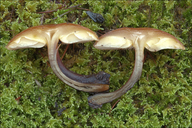|
|
click photo for larger file

Flammulina velutipes
Velvet Shank
|
Photographer: Dr. Amadej Trnkoczy
ID: 0000 0000 1214 2375 (2014-12-22)Copyright © 2014 Dr. Amadej Trnkoczy
|
|
INFORMATION PROVIDED WITH THE PHOTO
|
date of photo Nov 28, 2014
latitude 46.36066 longitude 13.70907
View on Google Maps.
location
Lower Trenta valley, between villages Soča and Trenta, sawmill Otokar, Trenta 4, East Julian Alps (Posočje, Slovenia)notes Slo.: zimska panjevka - Habitat: at the bottom of alpine valley, sawmill depot, next to the main road, flat terrain, full sun, humid place next to a river, exposed to direct rain, average precipitations ~ 3.000 mm/year, average temperature 7 - 9 deg C, elevation 550 m (1.800 feet), alpine phytogeographical region. - Substratum: a big log of Juglans regia lying on ground in a pile of timber in a sawmill depot. - Comments: Flammulina velutipes is a striking fungus in several senses in spite of the fact that it is a widespread, common and easy to recognize. First, it is very beautiful mushroom displaying a vibrant contrast between its like fire orange, shiny and half translucent hut and deep black velvety stipe. Its rich colors exemplify an eye-catching contrast to often dull gray-brown mood of late autumn and winter nature in my country or to snow covered habitats. Its pilei withstand very low temperatures. Even completely frozen they recover and grow and sporulate after temperature again rises above freezing point. One can find them from October to March being most frequent in January (Ref.:2.). Another interesting thing is that they need short wavelength light (blue 470 nm and above) to develop pilei and to sporulate (Ref.:2.). I haven't found an explanation why they need it. Generally fungi do not need light since they have no chlorophyll to synthesize their own food. - Flammulina velutipes grows as a saprobiont on wood of wide range of broadleaf trees, vast majority of them on Salix sp. and Fagus sylvatica. Fungi I found grew on Juglans regia, which is very seldom recorded. Only four of about thousand observations analyzed in Ref.:2. state Juglans regia as substratum. Taxonomy of this species is complex. Several taxa on f. and var. levels have been described. But, authors do not agree on them and Index Fungorum does not recognize them as valid names. The situation is well illustrated by the fact that there exist about 40 synonyms out of six genera. Also large differences in spore dimensions one can find in literature (see Fig. 2M) somehow confirm this. - Pilei photographed grew in several clusters, more than 80 pilei altogether were present; pileus diameter 1.8 - 4.5 cm and height 1.2 - 1.8 cm, upper surface very slimy, stipe diameter 3 - 4 mm above and 3.5 - 7 mm at the base, hollow when mature, tough, fairly fibrous and often flattened or twisted; taste mild slightly on soap; smell very mild but distinct, on bleach?, SP abundant white, oac909. - Spores dimensions: 7,0 [7,7 ; 8] 8,7 x 4,2 [4,6 ; 4,8] 5,2 microns; Q = 1,5 [1,6 ; 1,7] 1,8; N = 33; C = 95%; Me = 7,9 x 4,7 microns; Qe = 1,7. Olympus CH20, NEA 100x/1.25, magnification 1.000 x, oil, in water, Congo red. AmScope MA500 digital camera. - Herbarium: Mycotheca and lichen herbarium (LJU-Li) of Slovenian Forestry Institute, Večna pot 2, Ljubljana, Index Herbariorum LJF. - Ref.: (1) C. Bas, Flammulina in Western Europe, Persoonia (1983) 12 (1), pp 51-66 (cited in Ref.:2.) (2) G.J. Krieglsteiner (Hrsg.), Die Grosspilze Baden-Württembergs, Band 3., Ulmer (2001), p 245. (3) M. Bon, Parey's Buch der Pilze, Kosmos (2005), p 170. (4) R. M. Dähncke, 1200 Pilze in Farbfotos, AT Verlag (2009), p 389. (5) S. Buczacki, Collins Fungi Guide, Collins (2012), p 192. (6) R. Lueder, Grundkurs Pilzbestimmung, Quelle & Meyer (2008), p 388. (7) http://trace.tennessee.edu/cgi/viewcontent.cgi?article=1006&context=utk_ecolpubscamera Nikon D700/Nikkor Micro 105mm/f2.8
contributor's ID # Bot_851/2014_DSC4924 photo category: Fungi - fungi
|
MORE INFORMATION ABOUT THIS FUNGUS
|
| common names
Velvet Shank (photographer)
View all photos in CalPhotos of Flammulina velutipes Check Google Images for Flammulina velutipes |
|
The photographer's identification Flammulina velutipes has not been reviewed. Click here to review or comment on the identification. |
|
Using this photo The thumbnail photo (128x192 pixels) on this page may be freely used for personal or academic purposes without prior permission under the Fair Use provisions of US copyright law as long as the photo is clearly credited with © 2014 Dr. Amadej Trnkoczy.
For other uses, or if you have questions, contact Dr. Amadej Trnkoczy amadej.trnkoczy[AT]siol.net. (Replace the [AT] with the @ symbol before sending an email.) |
|
|
